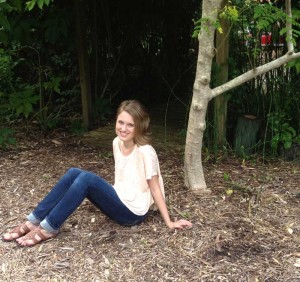Magazine features Shea as one of 10 innovators in annual Breakthrough Awards

Unionville High School graduate Meghan Shea was named one of Popular Mechanics magazine 2013 Innovators Who Changed The World for her invention of a simple and effective water filtration system for emerging nations. Shea is seen here with the moringa tree — seeds from this tree are a key element in her filter design.
By Mike McGann, Editor, The Times
A Unionville High School graduate was named Friday as one of “10 innovators who changed the world in 2013” by Popular Mechanics magazine.
Meghan Shea, a 2013 Unionville graduate and currently a freshman at Stanford University, was honored with one of its annual Breakthrough Awards by the magazine’s editors for her invention of an inexpensive water filter system that removes up to 99% of E. coli bacteria from water. She is one of 10 honorees featured in the November issue of the magazine that hits newsstands on Oct. 15. She and her fellow selectees will be formally honored at a ceremony on Oct. 22 in New York.
“Each year’s recipients are awe-inspiring as they shape our future through life-changing ideas and innovative products,” said James B. Meigs, editor-in-chief of Popular Mechanics, in a statement. “We are excited to recognize this year’s incredible list of visionaries, including Peter Diamandis, and share their breakthroughs that not only capture the imagination, but improve and save lives as well.”
This is the ninth year that the magazine has given out its Breakthrough Awards. Shea, a Birmingham resident, is the daughter of Peter Shea and Kathleen Brady Shea, who is managing editor of The Times.
Shea developed the filter during a summer science fellowship at Texas Tech University in 2012. There, she learned more about the moringa tree and its seeds — common in tropical environments. When ground up, the seeds trap impurities in water. Used in combination with a simple filtering system, the ground seeds proved a simple and inexpensive option for emerging countries with compromised water supplies.
The awards are presented in two categories: innovators whose inventions will make the world smarter, safer and more efficient, and products that are setting benchmarks in design and engineering today. Shea’s award is in the former category.
Past Breakthough Innovator Award winners include Tesla Motors and SpaceX founder Elon Musk, film director James Cameron, genomics pioneer J. Craig Venter, and humanitarian engineer Amy Smith.
In addition to Shea’s award, the other nine honorees are:
Leadership Award: Peter Diamandis – Through the XPRIZE Foundation, which he founded in 1995, serial entrepreneur Peter Diamandis has transformed the process of innovation, using competitions and cash prizes to jump-start major developments in the aerospace, automotive, environmental technology and life-science fields. Diamandis is also the co-founder and co-chairman of Planetary Resources, a company that will mine asteroids for raw materials, and the co-author of Abundance: The Future Is Better Than You Think.
Curiosity Mars Science Laboratory: John Grotzinger (Caltech, Jet Propulsion Laboratory), James Erickson (JPL) and teams – The Curiosity program proved that it is possible to deliver heavy payloads to Mars and collect valuable samples, helping lead to the discovery that ancient Mars would have been habitable for simple microorganisms.
General Motors Super Cruise: John Capp, Jeremy Salinger, Eric Raphael and team (General Motors) – GM has combined two existing technologies – adaptive cruise control and lane centering – into this system that allows for hands-free driving at highway speeds. It could be available in production vehicles as soon as 2018.
Indego Exoskeleton: Michael Goldfarb (Vanderbilt University), Ryan Farris (Parker Hannifin Corp.) and team – The Indego, a powered exoskeleton that is worn on the hips and legs, helps people with paraplegia stand, walk and even climb stairs. Powerful, battery-operated electric motors drive hip and knee joints, and the user operates the system by leaning forward to stand up or walk and by leaning back to sit down. A model for rehab clinics may be available by 2015.
X-47B: Capt. Jaime Engdahl and Don Blottenberger (U.S. Navy); Carl Johnson and Tim Kesecker (Northrop Grumman); and teams – The X47B is the first UAV (unmanned aerial vehicle) to land safely on the deck of an aircraft carrier without a human pilot. Its technology may lead to more accurate autopilot systems in private and commercial aircraft, as well as safer self-driving cars.
Oculus Rift: Palmer Luckey (Oculus VR, Inc.) – Oculus Rift is a revolutionary virtual-reality headset packed with accelerometers, gyroscopes, digital compasses and sophisticated optical systems that eliminates problems such as response lag that have kept VR (virtual reality) from ever reaching a wide audience. It is an immersive experience that is galvanizing excitement throughout the gaming industry. In the future, the technology may transform fields like architecture, data analysis, medicine and therapy.
3D Printed Tracheal Splint: Glenn Green and Scott Hollister (University of Michigan) – Six weeks after birth, Kaiba Gionfriddo almost died when a rare congenital condition caused his trachea to collapse. The team used a CT scan of Kaiba’s airway to design a custom-sized splint that was quickly manufactured using a 3D printer. The 3D-printed splint saved his life.
BioTac Sensor: Gerald Loeb (University of Southern California), Jeremy Fishel (SynTouch) and team – The BioTac senses things the way human fingertips do: force, vibration and temperature, and has similar mechanical properties. In one of its first applications, it outperformed blindfolded humans at identifying materials according to their texture. It will pave the way for a new generation of industrial, medical, and military robots, as well as prosthetic limbs.
Swarm Micro-UAVs: Vijay Kumar, Shaojie Shen and Matthew Turpin, (University of Pennsylvania); Nathan Michael (Carnegie Mellon University); Daniel Mellinger and Alex Kushleyev (KMel Robotics) – These small, autonomous quadrotors can fly in squadrons and spontaneously create maps or assemble a miniature truss structure. UAVs may change how we respond to disaster, perhaps even preventing losses beforehand by mapping challenging environments.







Trackbacks